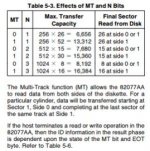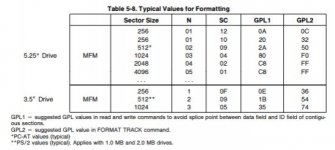Tonight, a friend showed me some information about the AT, PS/2-compatible 82077AA floppy disk controller. After reading over parts of the data sheet, I'm a bit confused and maybe someone who has access to one could run a test:
Does the 82077AA support 1.44 MB 3.5" floppy disks for reading and writing?
The first page of the data sheet suggests that it can, because the controller supports 1Mbps data rates. On the other hand, I noticed two parts of the data sheet which seem to contradict this:

First, the max transfer capacity for multitrack, a command available even on the NEC 765, only supports up to 15 sectors (1.2MB 5.25" floppies). In contrast, a 1.44Mb floppy with 512 byte sectors has 18 sectors per track.

Second, the suggested format parameters only show the recommended parameters for MFM double density 360k 5.25" and 720k 3.5" floppies. Notably, FM parameters, and high density 1.2MB 5.25"/1.44MB 3.5" parameters are absent. Is it possible that this datasheet just chose to omit these configurations and use a representative subset? What does 1.0MB and 2.0MB PS/2 mean in the footnote? Doesn't seem to correspond to any of the traditional PC formats.
Is it possible that 1.44MB drives just weren't that common, so they were excluded from these tables, but they are supported? If supported, does Multitrack work?
Does the 82077AA support 1.44 MB 3.5" floppy disks for reading and writing?
The first page of the data sheet suggests that it can, because the controller supports 1Mbps data rates. On the other hand, I noticed two parts of the data sheet which seem to contradict this:

First, the max transfer capacity for multitrack, a command available even on the NEC 765, only supports up to 15 sectors (1.2MB 5.25" floppies). In contrast, a 1.44Mb floppy with 512 byte sectors has 18 sectors per track.

Second, the suggested format parameters only show the recommended parameters for MFM double density 360k 5.25" and 720k 3.5" floppies. Notably, FM parameters, and high density 1.2MB 5.25"/1.44MB 3.5" parameters are absent. Is it possible that this datasheet just chose to omit these configurations and use a representative subset? What does 1.0MB and 2.0MB PS/2 mean in the footnote? Doesn't seem to correspond to any of the traditional PC formats.
Is it possible that 1.44MB drives just weren't that common, so they were excluded from these tables, but they are supported? If supported, does Multitrack work?
